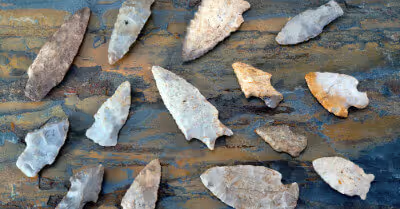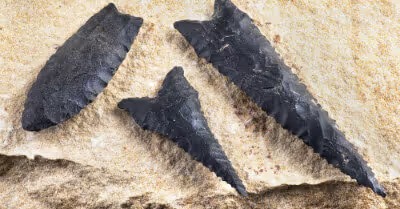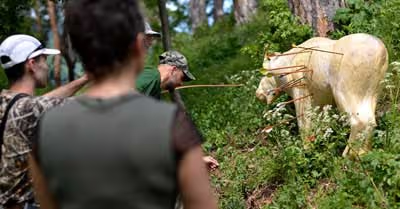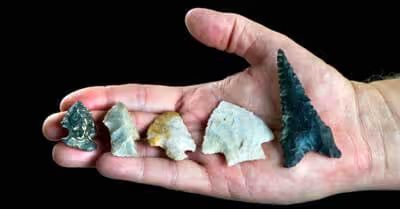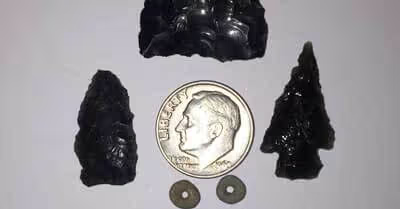Table of Contents
How to establish the age of an arrowhead
Establishing the age of an arrowhead relies upon the kind of stone or material it is made from. If the point is made of flint, exposure to sunlight, rain, air, and freezing over time will make it turn coarser. The colors will also turn lighter going towards white.
If the arrowhead is buried, there will sometimes be very little evident aging. But sometimes also, there will be a chemical reaction that happens on the flint's surface. A buried flint arrowhead will also have mineral deposits on it.
An arrowhead made of obsidian found in desert areas will appear polished because of blowing sand or dust and the wind, for its exposed side. The underside that comes in contact with the soil will be coated with the soil's chemical deposits. Sometimes, it is more original in feel.
When obsidian comes in contact with rain or moisture, it gets a hydration rind on its surface as time goes by. So, its originally slick and shiny appearance will become dull. When the arrowhead absorbs even small amounts of water, the outer layer will become thicker. This will depend on how long it is exposed to the elements.
The age of obsidian points is calibrated by archaeologists based on the hydration rind's thickness. They compare measurements of the rind to known dating methods. This will give them a rough age estimate based on the rind thickness. You can see the thickness of the rind by cutting the obsidian tool through.
The age of an arrowhead can also be determined by its size, style, and point source location. A lot of arrowhead styles were unique to certain periods. This can help us know when this type of arrowhead was used. Many specific styles were used in certain regions. This will help us identify a piece in a certain cultural context
Signs of use or wear of an arrowhead can also establish its age. Small damages to the blade or tips indicate wear. The once sharp edges had become smooth. And most prehistoric tool users sharpen the blades or dull tips of their tools. This changes the symmetrical blade to one which is off-balanced in form.
How to tell whether an arrowhead is genuine or hobby-made
One of the ways to tell whether an arrowhead is real is the place where it was located. If you found the arrowhead in a farmer's field, then it is very likely to be genuine. The field may have been an archaeological site.
Old arrowheads will most likely have imperfections, discolored and rough surfaces, and a patina. They will have plenty of flaws compared to one that is hobby-made. They mostly have flaws and chips from being re-sharpened or broken and discarded.
The main purpose of a hobby-made arrowhead is simply to display the skill of the creator. If flint knapping is done as a hobby, it will be very precise. There will be very fine flakes rather than the wide chips on the old arrowheads. Old arrowheads are often dull.
How they made and fit an arrowhead
A chipping process called knapping was how Native Americans made arrowheads. When flint is removed from a quarry, a piece of hard stone is used to reduce a large piece of flint by blowing on its edge. This type of chipping is repeated until the flint is properly thinned and shaped.
Then by using a sharpened elk or deer antler, the piece was pressure chipped. This will chip the edges finely until it becomes sharp. The next step was hafting. The arrowhead will then be fitted with a handle. The arrowhead is then fastened to an arrow, a spear shaft, a knife handle, or an atlatl shaft.
The arrowhead will be inserted into a split shaft. Then they use an animal tendon called sinew to wrap the end tightly.
These arrowheads and cutting blades were used by the ancient natives for survival and existence during our prehistory. Today, we consider these arrowheads or flint points as ancient works of art. They are like gems to us. Both young and adult alike treasure and collect these artifacts.
Many archaeologists have excavated layered sites where people of prehistory once lived and camped. These archaeologists were able to create a chronological sequence of different prehistoric cultures and the arrowheads associated with them using the process of carbon dating.
This is how we can identify different types of arrowheads found today in plowed fields, riverbanks, construction sites, and more.
Arrowheads can be tens of thousands of years old. When you find an arrowhead, you will be the first one, aside from the original owner, to touch it. It can be exciting to be able to hold your first arrowhead. You can have a lifelong hobby of collecting and learning about these arrowheads, which is a common Native American tool.
How to find old arrowheads
The arrowheads that we find can serve as our connection to the people who used them in the past. This shows us how different their methods and equipment are from what we use today.
Looking for arrowheads is just like scavenging for food. You need to think well about the process so that you can consistently find them instead of just finding them by accident.
Do your research. There are a lot of Native American tribes in the country. They have lived here for a very long time. If you want your search for stone arrowheads to narrow down, begin by studying about the different tribes that have lived in the area you are going to search on.
Most native tribes tilled the land and others caught fish with nets. Their common bond is that they hunted game. If you want to know more about the behaviors of these tribes, you can research online to understand their lives better.
If you know where the natives lived, you also need to know how the place looked like when they were living there. But things are different now. There are many structures today where the old Indians used to live. Over time rivers dry up and fields get overgrown. If you look at these places today, they will not look the same. This is why you need to go to historical records to get an idea of what the land looked like before.
During fishing and hunting seasons, these Native Americans set up camps. When salmon moved into tributaries to spawn, the natives moved to these places to fish. When wild turkey moved into fields to breed, the natives also migrated near these fields. If you find these season fishing and hunting grounds, then you will be able to find your arrowheads.
Also, look for their sources of water. You can find arrowheads in lakes, shallow creeks, ponds, and rivers because the water was an important part of the camp of Native Americans.
IF you want to consistently find arrowheads, consider the season. The best time of the year to search for one is during springtime. The reason for this is that the land is soft. During runoff, the topsoil is usually washed away.
If you are hunting for arrowheads in agricultural land, then a dicer may have turned over the soil. The key to finding arrowheads is when the soil below is exposed.
It is not good to hunt for arrowheads during summer since the ground is hard. During winter, the ground is covered with snow. It can be difficult to search for arrowheads during these seasons. Spring is the ideal season for arrowhead hunting. Aside from spring, you can also do your activity during fall, post-harvest.
When you search for arrowheads, you need to be careful to differentiate it from just a broken rock. It is quite easy to do this. A point, an edge, and a base make up an arrowhead. They are made from strong stone that could be sharpened. It is also made of very light stone so it can fly. Most arrowheads are made from flint, obsidian, and chert.
The arrowheads stones come from certain regions. For example, Native Americans used chert in Illinois and Missouri. If you find an arrowhead, find out to see if the material is locally available.
You will note that not all arrowheads are made of stone. Arrowheads in coastal areas are made from materials like oyster shells and clam. Oyster shells or hard-shell clams have the property of being easy to chip into a point and sharpen the edge.
You can also find arrowheads made of animal bone. Animal bone also has the same properties as oyster shells. You can easily make it pointed and make the edge sharp. Bone arrowheads are very common types.
Once you have found an arrowhead, the next thing to do is to identify it. It can be difficult to do so but there are online resources that you can use. One such resource is the Official Overstreet Indian Arrowhead Online Database.
You can easily recognize arrowheads even with their un-pristine conditions.
In this online database, there are over 60,000 images that have been collected over the years. Many serious collectors have contributed to this work. You can compare your find to the items in this database.
Whatever type of arrowhead you find, you will be able to connect with the hunters of the past through them.
How to identify arrowheads
To date, there are around 1,200 types of arrowheads that have been identified. These arrowheads were used by the Native Americans.
If you can identify your arrowheads, then it will allow you to learn more about the history and way of life of the people who made and used them. Many arrowheads are over a thousand years old.
Because of the number of types of arrowheads, you need to know how to be able to tell them apart. Below are some ways that an arrowhead can be identified.
You can identify an arrowhead by the material it is made of. This can be helpful especially if you don't know the location the arrowhead came from. Materials used on arrowheads are mostly found only in specific areas. Here specific tribes used these arrowheads.
Indian antique comes in many shapes. Pointed stones were connected to bolt shafts and used with a bow. Some arrowheads attached to a handle are often thrown for hunting animals like deer and others.
The configuration of the arrowhead is a very important point. Arrowheads were not perfect when they were made. But what they did was very much impressive since these tools were handmade and not made by machines. These tools were high in quality and show the Indians' creativity and motivation.
Arrowheads can be identified through the period and culture they were made according to their attributes. Over time, their thickness and shape may have changed due to various reasons. The most popular of the arrowheads, have bigger, finely made points.
The areas where the arrowheads were found can help identify it. If you are aware of the location where the arrowhead was found, you can narrow your options among the 1,200 types of arrowheads recorded and available.
Recent Articles



